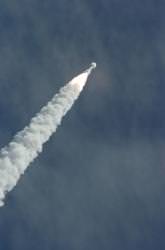If you think the Americans are going to be dominating lunar exploration, think again. Many countries are considering our heavenly companion, helping to unlock its secrets. The next mission to head off is the Japanese lunar probe Kaguya, which blasted off from the Tanegashima space center at 10:31:01 Japan Standard Time (01:31:01 UTC) on September 14th – after an initial delay due to weather. The spacecraft is currently in Earth orbit, and will leave for the moon on October 3rd. It’ll start making scientific observations on October 21st.
Once near the moon, Kaguya will split into three satellites; a 3-ton main orbiter which will orbit the planet at an altitude of 100km, and the smaller Relay and VRAD Satellites, which will orbit and gather information about the poles.
There are three main goals for the mission:
Kaguya will be on the moon to study how it evolved and where it came from by looking at the topography and the abundance of elements in the lunar soil, and measuring the Moon’s gravity and weak magnetic field. Hopefully, it’ll help explain the question: was the Moon captured by the Earth, did it solidify out of the same material and at the same time as our planet, was it somehow fissioned or secreted by the Earth, or is the result of a massive collision by another object.
It’ll also study the plasma, energetic particles and electromagnetic field surrounding the Moon. This will be valuable information, when humans arrive back at the Moon, decide to colonize, or utilize it as a base for other operations. Unlike the Earth, the Moon has no strong magnetic field to shield the surface from harmful radiation from the Sun, and if we are to travel there it will be essential to know what kind of protection we will need to bring along. The polar orbiters will also scope out possible sites for an astronomical observatory on the surface.
Finally, the probes will turn their electromagnetic eyes towards our planet to study the plasma surrounding the Earth, and allow us to better understand how our own magnetosphere and ionosphere protect us from the deadly radiation of the solar wind. One of the neatest aspects of the Kaguya mission is its inclusion of a High Definition Television camera to send back movies of the Earth from the Moon. This means that we will be able to see the Earth-rise from the Moon’s horizon!
Kaguya is the start of exciting times for Earth’s satellite, and for the continued exploration of our solar system. The launch of Kaguya kicks off the International Lunar Decade, ten years of lunar exploration that will end when humans once again land on the Moon. The International Lunar Decade is a project of The Planetary Society to foster international cooperation in studying the moon and invigorate the public about space exploration. Other missions in the spirit of the project include China’s lunar orbiter, Chang’E, which is set to launch sometime in 2007, and India’s Chandrayaan-1 mission, scheduled to launch this month.

